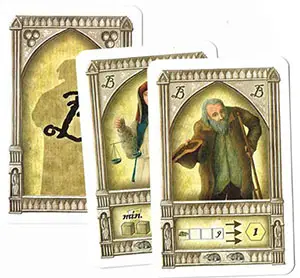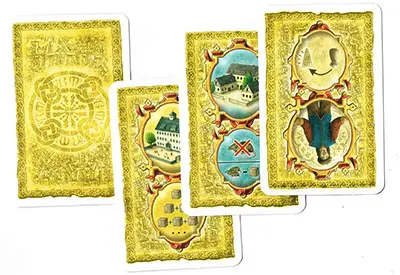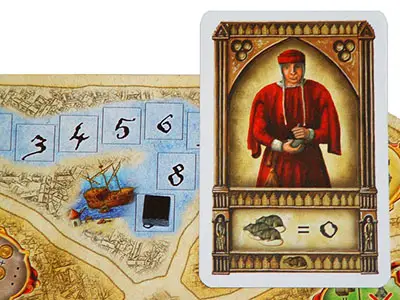
Players assume the roles of heads of influential families in Paris at the end of the 14th century. In the shadow of Notre Dame cathedral, players compete for prominence.
Players maximize wealth and prestige using action cards to shrewdly influence the sectors in their boroughs. Adding influence to banks increases access to money; spending on residences increases prestige. In addition to playing action cards, each round players have the opportunity to hire service professionals to help.
Players are presented with a myriad of alternatives, and must choose wisely. The most successful players will find just the right moment to take advantage of their opportunities. The player with the most prestige at the end is the winner.
Components

- 5 Game Board Sections
- 3 Notre Dame tiles
- 45 action cards
- 15 person cards
- 70 influence markers
- Black Markers (rat markers)
- 5 trusted friends
- 5 carriages
- 1 bell-ringer (+ plastic stand = start player figure)
- 20 messages
- 25 Gold Coins
- 84 Prestige Tokens
Setup
Arrange the sections of the game board in the middle of the table as shown below, using the Notre Dame tile that corresponds with the number of players:
-
3 players = 3-sided

-
4 players = 4-sided (with the side showing four figures face up)

-
5 players = 5-sided

Next, each player selects one game board section to be theirs, usually the one closest to where the player is sitting. Place unused game board sections and Notre Dame tiles back in the box.
Sort the prestige point tokens by value and place them along with the gold coins as supplies next to the game board.
Each player chooses a color and takes (in that color):
- the trusted friend, placed in the player's play area,
- the carriage, placed on the player's market place in the center of their borough,
- 4 influence markers, placed as a supply pile in the player's play area,
- 10 remaining influence markers, placed as general supply next to the game board,
- 4 messages, shuffled and randomly placed face up, one on each of the four edges of the marketplaces of the player's borough,
- 9 action cards, shuffled and placed face down in the player's play area as supply.
Each player also takes:
- 3 gold coins from the supply, placing them in their play area.
- 1 rat marker, placing it on space 0 of the plague track (0 to 9) in the harbor in the player's borough.
Place unused material back in the box.
Prepare the person cards in the following manner:
-

Shuffle the 6 brown person cards (which have no letters on their backs) and place as a face down stack next to the game board. Each of these persons is available once in each period.
-
Sort the 9 gray person cards according the the letters on their backs (A, B or C), shuffle each 3 card set, and place them as a single face down stack next to the person cards, so that the three C cards are on the bottom of the stack and the three B cards are in the middle of the stack.
Place the three A cards are on the top of the stack. Each of these persons will be available just once in the game.
The players choose a start player, who takes the bell-ringer.
Game Play
The game is played over three periods (A, B, and C), each of which has three rounds. Each of the 9 rounds has five phases, played in the order shown below:
Phase 1: Lay Out Person Cards

To begin each round, players lay out 3 person cards, drawing the top 2 cards from the stack of brown person cards (without letters), as well as 1 card from the top of the stack of gray person cards (with letter).
Place these 3 person cards face up next to the two card stacks.
Phase 2: Choose Action Cards

First, each player draws the top three cards from their individual action card stack, looks at them, chooses one to keep and passes the other 2 face down to the player to the left.
When all players have received passed cards, the players look at their two new cards, add one to their hand, and pass the other face down to the player to the left. Players then add this passed card to their hand.
It is important that players do not look at the card(s) they received from the players to their right until after they have passed cards.
Also, players may not pass a card that they had already added to their hand, i.e. they must pass one of the two cards received from the player to the right. Players always keep their cards secret from the other players.
Now each player has three action cards in their hand: one from their own stack of action cards, one from the player on the right, and one from the player sitting two places to their right. From these three cards, players choose two to use as actions in phase 3.
Phase 3: Play Action Cards
Beginning with the start player and continuing clockwise, each player chooses one action card from their hand, places it face up in their play area, and executes the action on the card.
After each player has played and executed their first action, each player (again starting with the start player and continuing clockwise) repeats this with a second action card from their hand.
Finally, players discard the action cards they played by placing them face up on a common discard stack.
Note: each player's third action card is not executed, but is instead simply discarded, hidden from other players underneath their second action card, onto the discard stack. Players are not allowed to look through cards in the discard stack!

Phase 4: Hire A Person
After all players have executed two and discarded all three action cards, each player may (in clockwise order, beginning with the start player) hire one of the three face up people to perform a special action once.
The cost to hire any person is one gold coin, paid to the supply. After paying a gold coin, the player uses the special ability of the hired person. If a player has no coins, or does not want to hire a person, the player may pass. Note: a person may be hired by more than one player (or even all players).
Phase 5: Determine Plague Value
In the last phase of each round, players determine who paid attention to the health of those in their borough, and who did not. Plague values are totaled and players move their rat marker along their plague track the number of spaces determined by the plague value plus or minus adjustments.

At the end of each round, players place their three face up person cards on the corresponding stack. The start player gives the bell-ringer to the player to the left, who becomes the new start player.
A new round begins. The new round plays the same as the previous: first phase 1, then phase 2, and so on through 3, 4, and 5.
At the end of each third round, there is a pause for:
- scoring of the influence markers in Notre Dame ;
- shuffling the six brown person cards and placing them face down as a stack;
- sorting all action cards by color and returning them to their owners. Players shuffle their cards and place them face down in their play areas.
End of the Game
After the end of the ninth round, the influence markers in Notre Dame are scored and the game ends. The player with the most prestige points is the winner.
If players tie for the most, then the player among them with the most total gold coins and influence markers in their personal supply is the winner.

The 2-player Game
Setup
Set up the board as for the 4-player game, but with the Notre Dame tile showing the side with 2 figures (= 6 prestige points per period). Each player takes one of the four boroughs, but the two chosen must be directly opposite each other. Proceed as described on page 2, "Preparation".
Note: In the two unassigned boroughs, the players place the messages for two unused colors, but do not place a carriage in that color.
When collecting messages, a player must collect all four colors used in the game (the 2 player's colors + the 2 others) before collecting a second of any one of the colors, and so on.
Whenever a player would move their marker beyond space 9, the player:
- places their rat marker on space 9
- loses 2 prestige points
- returns 1 influence marker to the general supply (from sector with the most)
Note: Each and every round, a new plague value will affect each player's position on their rat track. If a player neglects the health of their sector, their rat will move forward on the track more quickly.
In every round that a player's rat marker would move beyond the 9 on the rat track, the player loses 1 influence marker and 2 prestige points. While this penalty does not guarantee the player will lose, it certainly does not help their cause!
Game Play
All rules remain the same as for the 3-5 player game, except: in the 2nd phase, pass two cards to the other player, then get one back. Thus, each player has 2 cards of their own color, and one card from their opponent.
Continue Reading
